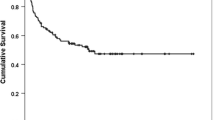Abstract
High-dose chemotherapy followed by autologous stem cell transplantation (ASCT) is part of the treatment strategy for some patients with high-risk lymphoma by improving survival with an acceptable toxicity profile. Although the BEAM (BCNU, etoposide, cytarabine, and melphalan) intensification regimen is the most used, the optimal dosing for each drug is unclear. Here, we retrospectively compared the outcome of 110 patients receiving higher (400 mg/m2, n = 69) or lower (200 mg/m2, n = 41) etoposide and cytarabine doses in our institution between 2012 and 2019. Patients in the BEAM 200 group experienced less toxicity with reduced fever duration (P < 0.001), number of platelet transfusions (P = 0.008), antibiotic duration (P < 0.001), antifungal therapy (P < 0.001), and mucositis (P < 0.001) whereas length of stay, admission to the intensive care unit, and in-hospital mortality were not different between groups. Progression-free survival (PFS) was non-significantly lower in the BEAM 200 group (36-month PFS, 68% vs. 80%, P = 0.053) whereas OS was similar between the two groups (36-month OS, 87% vs. 91%, respectively, P = 0.12). Albeit a non-significant reduction in PFS, BEAM 200 conditioning intensity was associated with a reduced toxicity profile.

Similar content being viewed by others
Data availability
The datasets analyzed during the current study are available from the corresponding author upon reasonable request.
References
Milpied N, Deconinck E, Gaillard F et al (2004) Initial Treatment of Aggressive Lymphoma with High-Dose Chemotherapy and Autologous Stem-Cell Support. N Engl J Med 350:1287–1295. https://doi.org/10.1056/NEJMoa031770
Linch DC, Goldstone AH, McMillan A et al (1993) Dose intensification with autologous bone-marrow transplantation in relapsed and resistant Hodgkin’s disease: results of a BNLI randomised trial. The Lancet 341:1051–1054. https://doi.org/10.1016/0140-6736(93)92411-L
Philip T, Guglielmi C, Hagenbeek A et al (1995) Autologous Bone Marrow Transplantation as Compared with Salvage Chemotherapy in Relapses of Chemotherapy-Sensitive Non-Hodgkin’s Lymphoma. N Engl J Med 333:1540–1545. https://doi.org/10.1056/NEJM199512073332305
Gisselbrecht C, Glass B, Mounier N et al (2010) Salvage Regimens With Autologous Transplantation for Relapsed Large B-Cell Lymphoma in the Rituximab Era. J Clin Oncol 28:4184–4190. https://doi.org/10.1200/JCO.2010.28.1618
van Imhoff GW, McMillan A, Matasar MJ et al (2017) Ofatumumab Versus Rituximab Salvage Chemoimmunotherapy in Relapsed or Refractory Diffuse Large B-Cell Lymphoma: The ORCHARRD Study. J Clin Oncol 35:544–551. https://doi.org/10.1200/JCO.2016.69.0198
Le Gouill S, Thieblemont C, Oberic L et al (2017) Rituximab after Autologous Stem-Cell Transplantation in Mantle-Cell Lymphoma. N Engl J Med 377:1250–1260. https://doi.org/10.1056/NEJMoa1701769
Geisler CH, Kolstad A, Laurell A et al (2008) Long-term progression-free survival of mantle cell lymphoma after intensive front-line immunochemotherapy with in vivo–purged stem cell rescue: a nonrandomized phase 2 multicenter study by the Nordic Lymphoma Group. Blood 112:2687–2693. https://doi.org/10.1182/blood-2008-03-147025
Caballero M, Rubio V, Rifon J et al (1997) BEAM chemotherapy followed by autologous stem cell support in lymphoma patients: analysis of efficacy, toxicity and prognostic factors. Bone Marrow Transplant 20:451–458. https://doi.org/10.1038/sj.bmt.1700913
Mills W, Chopra R, McMillan A et al (1995) BEAM chemotherapy and autologous bone marrow transplantation for patients with relapsed or refractory non-Hodgkin’s lymphoma. J Clin Oncol 13:588–595. https://doi.org/10.1200/JCO.1995.13.3.588
Chopra R, McMillan A, Linch D et al (1993) The place of high-dose BEAM therapy and autologous bone marrow transplantation in poor-risk Hodgkin’s disease. A single-center eight- year study of 155 patients. Blood 81:1137–1145. https://doi.org/10.1182/blood.V81.5.1137.1137
Mills W, Strang J, Goldstone AH, Linch DC (1995) Dose Intensification of Etoposide in the BEAM ABMT Protocol for Malignant Lymphoma. Leuk Lymphoma 17:263–270. https://doi.org/10.3109/10428199509056831
Martín A, Caballero MD, Pérez-Simón JA et al (2004) Results of autologous transplantation in lymphoma are not improved by increasing the dose of etoposide in the BEAM regimen: a single-centre sequential-cohort study. Bone Marrow Transplant 34:675–682. https://doi.org/10.1038/sj.bmt.1704595
Cheson BD, Pfistner B, Juweid ME et al (2007) Revised Response Criteria for Malignant Lymphoma. J Clin Oncol 25:579–586. https://doi.org/10.1200/JCO.2006.09.2403
Yeral M, Aytan P, Gungor B et al (2020) A Comparison of the BEAM and MITO/MEL Conditioning Regimens for Autologous Hematopoietic Stem Cell Transplantation in Hodgkin Lymphoma: An Analysis of Efficiency and Treatment-Related Toxicity. Clin Lymphoma Myeloma Leuk 20:652–660. https://doi.org/10.1016/j.clml.2020.05.009
Martin N, Borchiellini D, Coso D et al (2015) High-dose chemotherapy with carmustine, etoposide, cytarabine and melphalan followed by autologous stem cell transplant is an effective treatment for elderly patients with poor-prognosis lymphoma. Leuk Lymphoma 56:2379–2387. https://doi.org/10.3109/10428194.2014.1001987
Marchesi F, Capria S, Giannarelli D et al (2018) BEAM vs FEAM high-dose chemotherapy: retrospective study in lymphoma patients undergoing autologous stem cell transplant. Bone Marrow Transplant 53:1051–1054. https://doi.org/10.1038/s41409-018-0120-x
Sakellari I, Mallouri D, Batsis I et al (2015) Carmustine, etoposide, cytarabine and melphalan versus a newly designed intravenous busulfan-based Busulfex, etoposide and melphalan conditioning regimen for autologous hematopoietic cell transplant: a retrospective matched-pair analysis in advanced Hodgkin and non-Hodgkin lymphomas. Leuk Lymphoma 56:3071–3081. https://doi.org/10.3109/10428194.2015.1028054
Acknowledgements
We would like to thank patients and their families for participating in this study.
Author information
Authors and Affiliations
Contributions
AV and CO contributed to the study conception and design; AV collected the data; AV, JP, MHB, and CO prepared the first draft of the manuscript; All authors contributed to the data analysis and to the critical revision. All authors read and approved the final manuscript.
Corresponding author
Ethics declarations
Competing interests
Employment or Leadership Position: none; Consultant or Advisory Role: MHB, Erytech©; Stock Ownership: none; Honoraria: CO, Novartis, MHB, Abbvie, Incyte, and Jazz Pharmaceuticals; Research Funding: none; Expert Testimony: none; Patents: none; Other Remuneration: none.
Additional information
Publisher's note
Springer Nature remains neutral with regard to jurisdictional claims in published maps and institutional affiliations.
Supplementary Information
Below is the link to the electronic supplementary material.
Rights and permissions
Springer Nature or its licensor (e.g. a society or other partner) holds exclusive rights to this article under a publishing agreement with the author(s) or other rightsholder(s); author self-archiving of the accepted manuscript version of this article is solely governed by the terms of such publishing agreement and applicable law.
About this article
Cite this article
Vely, A., Paillassa, J., Nunes Gomes, C. et al. Toxicity Profile According to Etoposide and Cytarabine Dosing in Patients with Lymphoma Receiving Autologous Stem Cell Transplantation Following BEAM Conditioning. Ann Hematol 102, 2225–2231 (2023). https://doi.org/10.1007/s00277-023-05333-z
Received:
Accepted:
Published:
Issue Date:
DOI: https://doi.org/10.1007/s00277-023-05333-z




